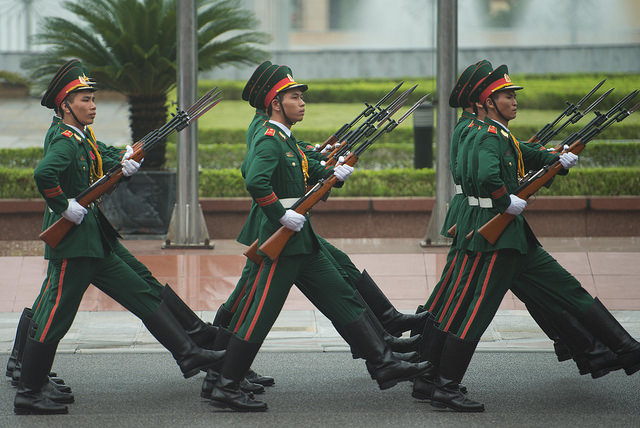Vietnam boosted its military spending by 113 percent between 2004 and 2013, the largest increase among Southeast Asian countries. Defense spending has accounted for around 2 percent of the country’s gross domestic product since 2004. Total spending was $3.3 billion in 2012 and $3.4 billion in 2013 (the latest year for which figures are available), and according to IHS Jane’s, signed military procurement contracts in 2014 worth $1.4 billion.
The year 2011 marked a turning point for Vietnam’s defense spending. That year the Central Committee of the ruling Communist Party issued a detailed maritime strategy for 2011-2020, making the protection of maritime sovereignty and the maritime economy key national security pillars. Vietnam has a 2,000-mile coastline facing the South China Sea and 50 percent of its population living along the coast, and the government sees its largest security threat as external and maritime in nature.
The Vietnamese Navy and Air Force, which until the early 2000s had little capacity to protect Vietnam’s maritime interests, have over the past decade undergone rapid modernization. Russia is Vietnam’s main arms supplier thanks to ties dating back to the Cold War. The major platforms acquired since 2011 served to upgrade Vietnam’s ability to conduct sea denial operations off its coast and around military installations in the disputed Spratly islands.
Most notably, the Kilo-class submarine deal, signed in 2009 with Russia, is worth approximately $3.2 billion and includes submarines and construction of a submarine facility at the deep water port in Cam Ranh Bay. The Navy is expected to operate a total of six Kilo-class submarines by 2017. The first two have been on training runs for the past year and could be sent further offshore soon.
Vietnam received two Gepard-class guided missile stealth frigates from Russia in 2011 at a cost of $300 million and, by mid-2017, will operate six Gepard-class frigates. The first two received were configured to respond to surface attacks. Two others will have anti-submarine warfare capabilities and two are expected be equipped with air defense missiles. These will be the Navy’s most valuable assets until it receives four Sigma-class corvettes equipped with Exocet missiles from the Netherlands in the coming years.
Four Svetlyak-class fast patrol boats with anti-ship missiles have been received from Russia since 2010. The Navy also operates a dozen frigates or corvettes that were either from the Soviet era or co-manufactured with Russia more recently. In 2014, the Navy added its first two Molniya-class missile fast attack ships, built domestically but based on Russian designs, and it is expecting four more by the end of 2016.
The Air Force acquired 24 Su-30 MK2 fighter jets from Russia during the past decade, and recently ordered another 12 for over $1.6 billion. By the end of 2015, it will operate 36 Su-30 MK2 jets. These advanced, anti-ship missile-capable aircraft will join a fleet of about 50 older Su-27 and Su-22 models and over 140 aging Vietnam War-era MiG-21s.
Vietnam has ordered six DHC-6 twin otter seaplanes from Canada, three of which have been received. Reports by IHS Jane’s last year said Vietnam had ordered three C295 military transport aircraft from Spain for $100 million. Chinese sources claim that Vietnam plans to convert these aircraft for early warning purposes, long a weakness of Vietnam’s air force. The new C295s will enter service in 2015, joining a fleet of over 50 Soviet-built transport planes that Vietnam already operates.
Vietnam has also continuously upgraded its defensive missile systems. It put in place two batteries of the K-300P Bastion coastal missile system in 2011 and two batteries of the S-300 PMU-2 long-range surface-to-air missile systems in 2012. In 2014, Vietnam upgraded both its short-range surface-to-air missile systems and coastal missile systems. The military has been boosting its coastal surveillance radar systems since 2013, and successfully built its first unmanned aerial vehicle in 2013.
The government has allocated over $950 million since 2014 to upgrade law enforcement capabilities for its Coast Guard and Fisheries Surveillance Force, according to Vietnamese news reports. While it has spent more lavishly on the Navy, Vietnam relies largely on its Coast Guard and Fisheries Surveillance Force for patrolling and protecting Vietnamese interests in the South China Sea.
The Coast Guard currently is believed to have around 38 vessels ranging from 120 to 2,500 tons. Many of these vessels were built domestically. The largest offshore patrol vessel, built by the Netherlands, will be equipped with naval helicopters for better maritime surveillance. The Coast Guard has added two CASA C-212 400 maritime patrol aircraft since 2011. The government in 2014 ordered the construction of 32 new patrol vessels and four large fisheries surveillance vessels, and in February began arming its fisheries surveillance units with military weapons.
The United States and Japan have emerged as Vietnam’s closest security partners over the past few years, given their shared concerns about China’s growing assertiveness and interest in maintaining freedom of navigation in the South China Sea. Washington in 2013 announced an $18 million maritime security assistance package for Hanoi and will transfer five coast guard cutters to Vietnam annually over the next five years. The United States also has been training the country’s coast guard personnel. Vietnam will begin receiving decommissioned Japanese coast guard vessels in 2015.
Despite the Vietnamese government’s significant military modernization over the past five years, the task ahead remains daunting. Questions abound over whether the Navy and Air Force can absorb the added capacity in a relatively short time, whether the Coast Guard will be able to withstand stepped-up Chinese assertiveness at sea, and whether Hanoi can maintain the current level of spending in future years. Many defense officials in Washington are waiting for Vietnam to expand its coast guard cooperation, forge closer naval ties, and establish a defense procurement relationship with the United States.
